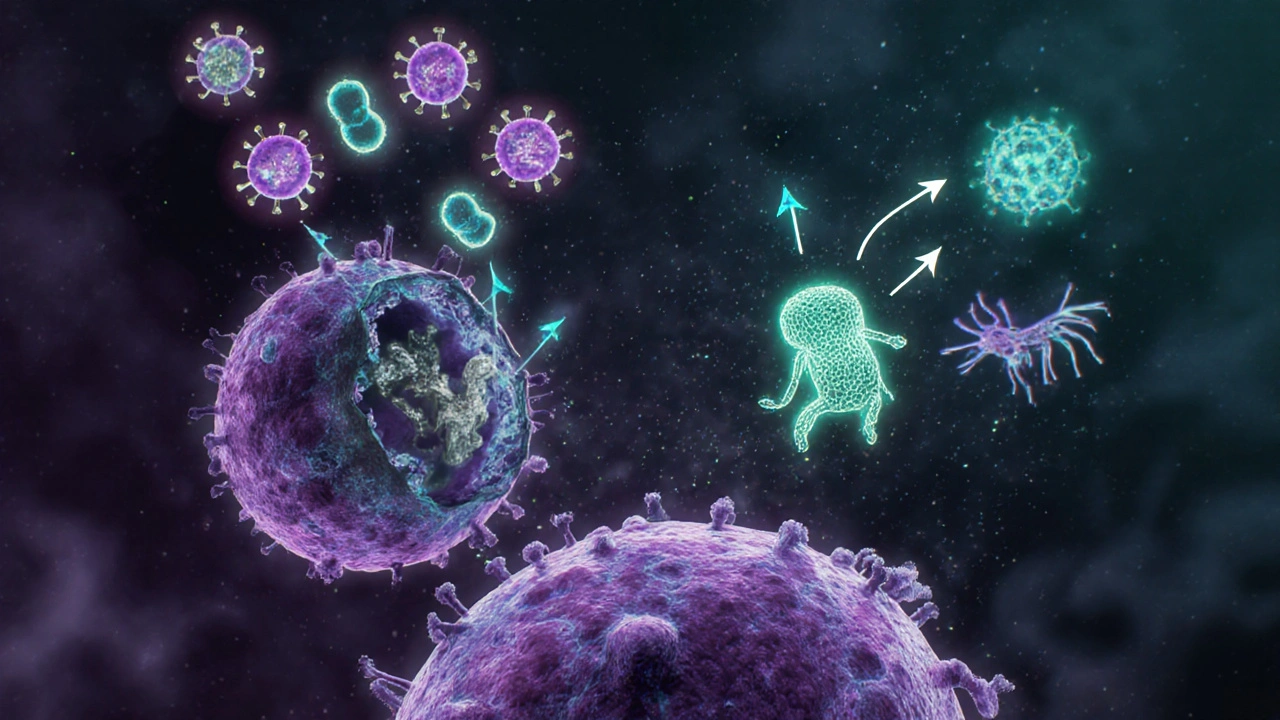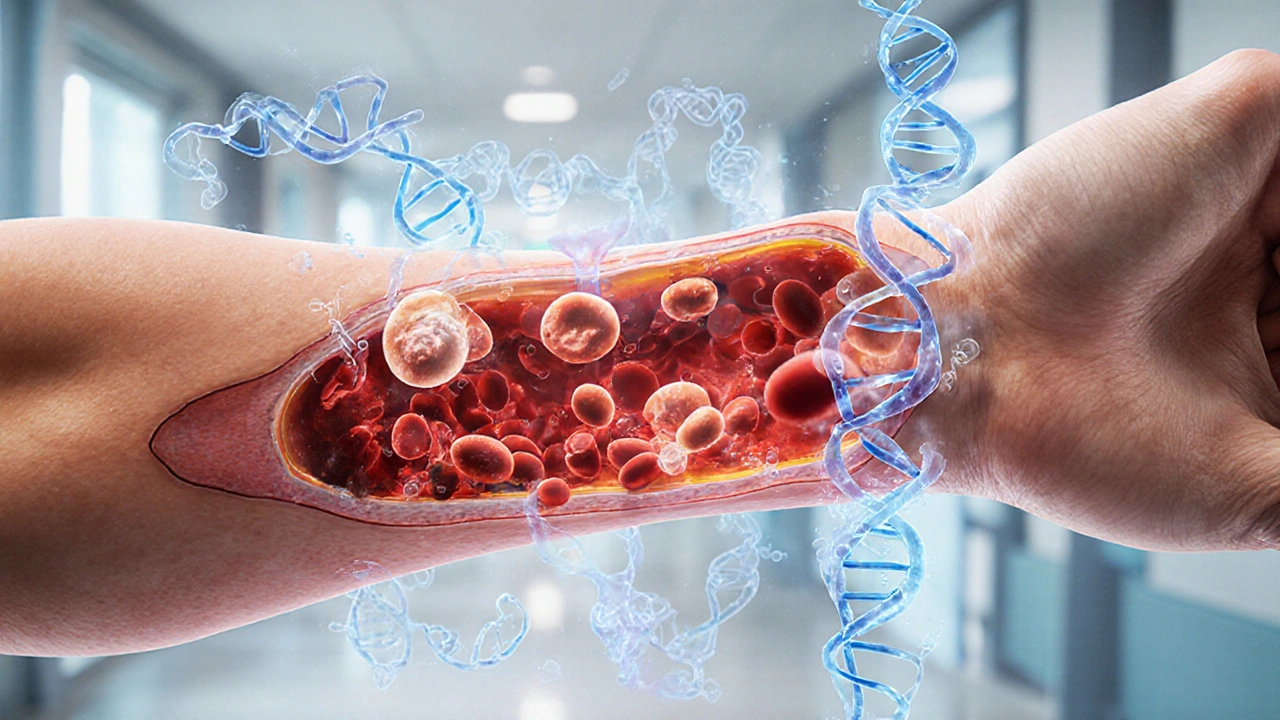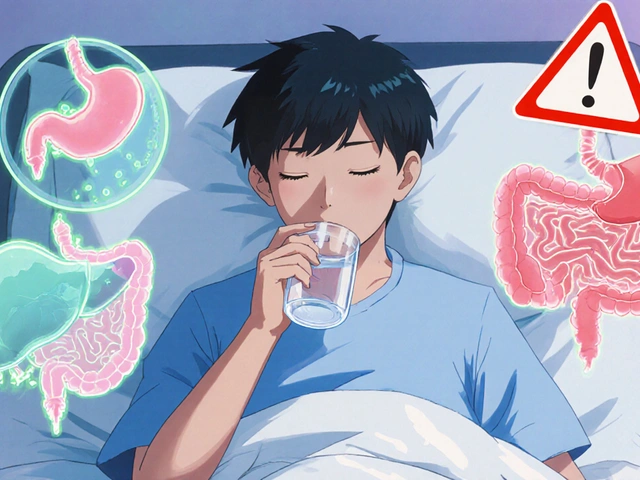Genetic Risk Calculator for Candidemia
Assess Your Risk for Genetic Susceptibility to Candidemia
This calculator estimates the likelihood of having a genetic predisposition to candidemia based on clinical features and family history. It's designed for healthcare professionals to aid in clinical decision-making.
Results are for informational purposes only and should not replace clinical evaluation.
Clinical Information
When a patient suddenly develops a bloodstream infection caused by Candida, doctors call it Candidemia is a severe infection where Candida species enter the bloodstream and can spread to multiple organs. While catheters, broad‑spectrum antibiotics, and immune suppression are classic risk factors, a growing body of evidence shows that our DNA can tip the balance too. In fact, certain genetic variants make some people far more vulnerable, even without the usual hospital‑related triggers. This article unpacks the science, the clinical impact, and what you can do if you suspect a genetic predisposition.
Key Takeaways
- Rare, loss‑of‑function mutations in genes such as CARD9 and the receptor Dectin‑1 (CLEC7A) dramatically increase the risk of candidemia and disseminated disease.
- Genome‑wide association studies (GWAS) have identified common variants that modestly raise susceptibility, especially in patients with underlying immune defects.
- Genetic defects impair the IL‑17 pathway is critical for recruiting neutrophils and controlling Candida growth at mucosal surfaces, leading to persistent bloodstream invasion.
- Targeted genetic testing can guide prophylaxis, inform treatment selection, and prevent recurrent episodes.
- Future therapies may include gene‑editing or biologics that restore the missing immune signals.
Understanding Candidemia and Disseminated Candida Infections
Disseminated Candida infection is the spread of Candida from the bloodstream to organs such as the brain, eyes, kidneys, and heart. Mortality can exceed 40% in intensive care settings, making early recognition vital. While most cases occur in patients with central venous catheters, neutropenia, or recent surgery, roughly 10‑15% of infections arise in individuals without obvious risk factors - a clue that genetics may be at play.
Genetic Susceptibility: Core Pathways
Three biological themes dominate the genetic landscape of candidemia:
- Pattern Recognition Receptors (PRRs) - proteins that spot fungal cell wall components. The best‑studied PRR is Dectin‑1 (gene CLEC7A). Loss‑of‑function mutations prevent the immune system from recognizing β‑glucans, a key fungal polysaccharide, leading to unchecked growth.
- Signal Transduction Hubs - once PRRs bind Candida, intracellular adaptors like CARD9 is an adaptor protein that links Dectin‑1 signaling to NF‑κB activation and cytokine production. CARD9 deficiency is the most common monogenic cause of invasive candidiasis, with over 30 published cases worldwide.
- Cytokine Axes - especially the IL‑17 pathway. Mutations in STAT3 or the IL‑17 receptor genes (IL17RA, IL17RC) blunt neutrophil recruitment, a hallmark of chronic mucocutaneous candidiasis that can also predispose to bloodstream invasion.
Other players include IFN‑γ signaling is essential for activating macrophages that engulf Candida yeast and Toll‑like receptor 2 (TLR2), which adds a secondary layer of detection.

What GWAS Have Told Us
Large‑scale genome‑wide association studies across European and Asian cohorts have spotlighted several single‑nucleotide polymorphisms (SNPs) that modestly raise the odds of candidemia. For instance, the rs11089677 variant near the PLCG2 gene is associated with a 1.4‑fold increase in risk among ICU patients. While each SNP adds only a small effect, the cumulative polygenic risk score can identify patients who might benefit from antifungal prophylaxis.
How Genetic Defects Alter the Immune Response
When a healthy immune system meets Candida, the sequence is roughly:
- PRRs such as Dectin‑1 bind fungal β‑glucan.
- CARD9 transduces the signal, activating NF‑κB and MAPK pathways.
- IL‑6, IL‑1β, and IL‑23 are released, driving Th‑17 differentiation.
- IL‑17A/F recruit neutrophils to the infection site.
- Neutrophils engulf and kill the yeast; macrophages clear any lingering hyphae.
Mutations at any step break the chain. A Dectin‑1 loss‑of‑function prevents step 1; CARD9 deficiency stalls step 2; IL‑17 pathway defects block step 4, leaving the bloodstream vulnerable. The end result is the same: Candida grows unchecked, spills into the blood, and can seed distant organs.
Clinical Implications: Diagnosis, Screening, and Personalized Therapy
Recognizing a genetic predisposition changes three practical aspects of care:
- Risk Stratification - Patients with known CARD9 or Dectin‑1 mutations should receive antifungal prophylaxis during high‑risk periods (e.g., chemotherapy, post‑surgical ICU stays).
- Targeted Treatment - Those with IL‑17 pathway defects may respond better to echinocandins, which inhibit β‑glucan synthesis, rather than azoles that rely on host immune clearance.
- Family Screening - Because many of these mutations are autosomal recessive, sibling testing can uncover silent carriers who might need counseling before undergoing immunosuppressive therapy.
In practice, a step‑wise algorithm works well:
- Identify patients with recurrent or unexplained candidemia.
- Order a targeted gene panel (CARD9, CLEC7A, STAT3, IL17RA, IL17RC, IFNG).
- Interpret results with a clinical geneticist.
- Implement prophylaxis or adjust antifungal regimen based on the defect.
Testing and Genetic Counseling
Modern next‑generation sequencing panels can return results in under two weeks and cost roughly £800-£1,200 in the UK. A negative panel does not rule out a genetic contribution; rare variants may still be uncovered by whole‑exome sequencing. Genetic counselors play a key role in explaining penetrance (often 30‑50% for CARD9) and discussing reproductive options.
Future Directions: From Gene Therapy to Precision Immunomodulation
Exciting work is underway to correct CARD9 deficiency using CRISPR‑based editing in hematopoietic stem cells. Early‑phase trials in mouse models show restored Dectin‑1 signaling and complete protection against lethal candidemia. Parallel efforts are testing recombinant IL‑17A or IL‑22 therapeutics to bypass defective Th‑17 pathways. While still experimental, these approaches illustrate a shift from broad‑spectrum antifungals to tailored immunotherapy.
Quick Reference Table
| Gene | Typical Mutation | Immune Effect | Clinical Clue |
|---|---|---|---|
| CARD9 | Loss‑of‑function (nonsense, splice) | Blocks Dectin‑1 signaling → no NF‑κB activation | Repeated candidemia, often in childhood |
| CLEC7A (Dectin‑1) | Y238X premature stop | Fails to recognize β‑glucan | Oral thrush + bloodstream infection in otherwise healthy adults |
| STAT3 | Dominant missense | Impairs Th‑17 differentiation | Chronic mucocutaneous candidiasis + autoimmunity |
| IL17RA | Recessive loss‑of‑function | Blocks IL‑17 signaling | Severe oral/genital candidiasis, occasional bloodstream spread |
| IFNG | Missense affecting IFN‑γ production | Reduces macrophage activation | Disseminated infection with low IFN‑γ levels |
Frequently Asked Questions
Can anyone develop candidemia because of genetics?
Genetic susceptibility mainly affects people with rare, high‑impact mutations like CARD9 deficiency. However, common variants identified by GWAS add modest risk, so genetics can tilt the odds even in otherwise typical patients.
Should I get genetic testing after one episode of candidemia?
If the infection was unexplained, recurrent, or occurred without classic risk factors, a targeted gene panel is worthwhile. Discuss the decision with an infectious disease specialist and a genetics counselor.
Do antifungal drugs work differently in patients with genetic defects?
Yes. For example, echinocandins are preferred for Dectin‑1 or CARD9 defects because they target the fungal cell wall directly, bypassing the need for an intact immune response. Azoles rely more on host immunity, so they may be less effective in severe immune defects.
Is there a cure for genetic predisposition to candidemia?
Currently, management focuses on prevention and early treatment. Gene‑editing therapies are promising but still experimental. Ongoing clinical trials are evaluating stem‑cell approaches for CARD9 deficiency.
How common are these genetic mutations in the general population?
Rare, high‑impact mutations like CARD9 loss‑of‑function occur in roughly 1 in 200,000 individuals. Common GWAS‑identified SNPs have allele frequencies of 5‑20% but each contributes only a small increase in risk.







Georgia Nightingale
October 6, 2025 AT 15:01Reading through this piece feels like stepping into a modern myth where our DNA is both the hero and the villain of infection. The way CARD9 and Dectin‑1 are portrayed reminds me of ancient tales where a single broken shield could doom an entire army. Yet here, a single loss‑of‑function mutation can open the gates for Candida to march unchecked into the bloodstream. It’s fascinating how a tiny alteration in the IL‑17 pathway can ripple across the immune landscape, turning a harmless commensal into a lethal invader. The authors correctly highlight that these rare monogenic defects are the tip of an iceberg, but the iceberg is composed of many small pebbles – the GWAS‑identified SNPs that nudge risk ever so slightly. In practice, the challenge is distinguishing a patient whose single episode is merely a stochastic event from one whose genetic script is pre‑written for tragedy. The calculator they provide is an elegant attempt at quantifying that risk, but I worry about over‑reliance on a point system that may not capture epistatic interactions. Moreover, the emphasis on prophylactic echinocandins in CARD9‑deficient individuals raises ethical questions about antimicrobial stewardship. Should we pre‑emptively treat based on a genetic ticket, or reserve such measures for clinically evident vulnerability? The future direction hinted at – CRISPR editing of hematopoietic stem cells – sounds like science‑fiction turned reality, yet we must temper excitement with caution about off‑target effects. As we move toward precision immunotherapy, the balance between correcting a faulty pathway and preserving the subtle checks that prevent autoimmunity becomes delicate. Ultimately, the article serves as a reminder that genetics is not destiny; environmental triggers, microbial virulence, and host resilience still play starring roles. The interplay of these factors makes each case a unique puzzle, demanding both molecular insight and clinical acumen. In the end, perhaps the most profound takeaway is that we must keep listening to the whispers of our genome while never ignoring the louder voice of bedside observation.
Chris Kivel
October 6, 2025 AT 23:21Solid overview, thanks for the deep dive.
sonia sodano
October 7, 2025 AT 07:41While the article glorifies genetic testing as the ultimate answer, we must remember that most patients never need a fancy panel to survive a Candida infection. The focus on rare monogenic defects distracts from the very real impact of hospital practices, like catheter care and antimicrobial stewardship. In many low‑resource settings, genetic screens are a luxury, yet candidemia rates remain high. So perhaps the narrative should shift from "who has the gene?" to "what can we do now to prevent infection for everyone".
Praveen Kumar BK
October 7, 2025 AT 16:01There are several factual inaccuracies in the previous comment that need correcting. First, the statement that "most patients never need a fancy panel" ignores the increasing evidence that polygenic risk scores can guide prophylaxis even in resource‑limited hospitals. Second, the claim that genetic screens are a luxury is outdated; many rapid PCR‑based panels are now affordable. Lastly, the phrasing "what can we do now" is vague – specific measures such as line‑bundle protocols and early echinocandin use should have been mentioned.
Viji Sulochana
October 8, 2025 AT 00:21lol i once had a friend with a weird candida issue and we thought it was just diet but turns out her family had a CARD9 thing lol guess genetics can be sneaky 🤷♀️ hope docs check it out early.
Stephen Nelson
October 8, 2025 AT 08:41Oh great, another exhaustive list of genes to make us feel even more inferior. Because what the world really needed was yet another spreadsheet of mutations to memorize.
Fredric Chia
October 8, 2025 AT 17:01The preceding commentary, while colorful, fails to provide actionable data. A concise recommendation: prioritize echinocandin therapy for confirmed CARD9 deficiency and consider prophylaxis only in high‑risk ICU cohorts with documented polygenic risk above the 80th percentile.
Hope Reader
October 9, 2025 AT 01:21Well said 😊
Marry coral
October 9, 2025 AT 09:41Stop hiding behind fancy gene panels – just give everyone a strong antifungal when they’re on broad antibiotics, it’s the only way to actually stop the spread.
Emer Kirk
October 9, 2025 AT 18:01yeah but what about the side effects i mean you cant just throw meds at everyone they might get sick from the drugs too
Roberta Saettone
October 10, 2025 AT 02:21Practical takeaway: if you encounter a patient with recurrent candidemia and no clear iatrogenic cause, order a targeted gene panel – it’s cost‑effective compared to repeated admissions. And remember, echinocandins remain the drug of choice for those with suspected innate immune defects.
Sue Berrymore
October 10, 2025 AT 10:41Absolutely! Let’s keep pushing for early testing – the sooner we know, the sooner we can tailor therapy and maybe even save a life. Together we can turn these genetic insights into real‑world victories.
Jeffrey Lee
October 10, 2025 AT 19:01Honestly this whole thing feels like a westerner's hype about genetics. In america we already have the best labs and we dont need some fancy calculator to tell us who is at risk. Just use common sense and good hygiene.